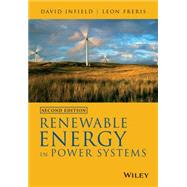An up to date account of renewable sources of electricity generation and their integration into power systems
With the growth in installed capacity of renewable energy (RE) generation, many countries such as the UK are relying on higher levels of RE generation to meet targets for reduced greenhouse gas emissions. In the face of this, the integration issue is now of increasing concern, in particular to system operators.
This updated text describes the individual renewable technologies and their power generation characteristics alongside an expanded introduction to power systems and the challenges posed by high levels of penetrations from such technologies, together with an account of technologies and changes to system operation that can ease RE integration.
Features of this edition:
- Covers power conditioning, the characteristics of RE generators, with emphasis on their time varying nature, and the use of power electronics in interfacing RE sources to grids
- Outlines up to date RE integration issues such as power flow in networks supplied from a combination of conventional and renewable energy sources
- Updated coverage of the economics of power generation and the role of markets in delivering investment in sustainable solutions
- Considers the challenge of maintaining power balance in a system with increasing RE input, including recent moves toward power system frequency support from RE sources
- Offers an insightful perspective on the shape of future power systems including offshore networks and demand side management
- Includes worked examples that enhance this edition’s suitability as a textbook for introductory courses in RE systems technology
Firmly established as an essential reference, the Second Edition of Renewable Energy in Power Systems will prove a real asset to engineers and others involved in both the traditional power and fast growing renewables sector. This text should also be of particular benefit to students of electrical power engineering and will additionally appeal to non-specialists through the inclusion of background material covering the basics of electricity generation.








